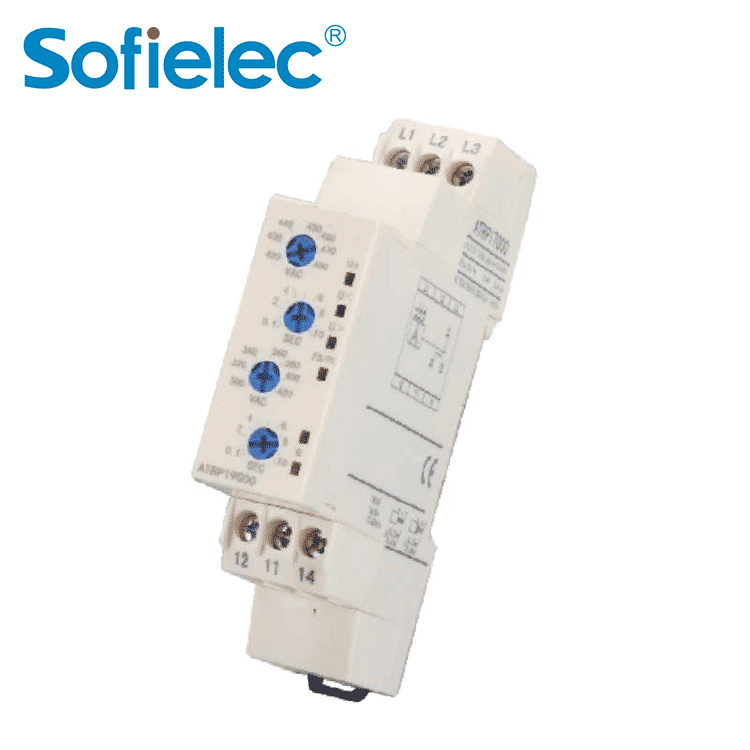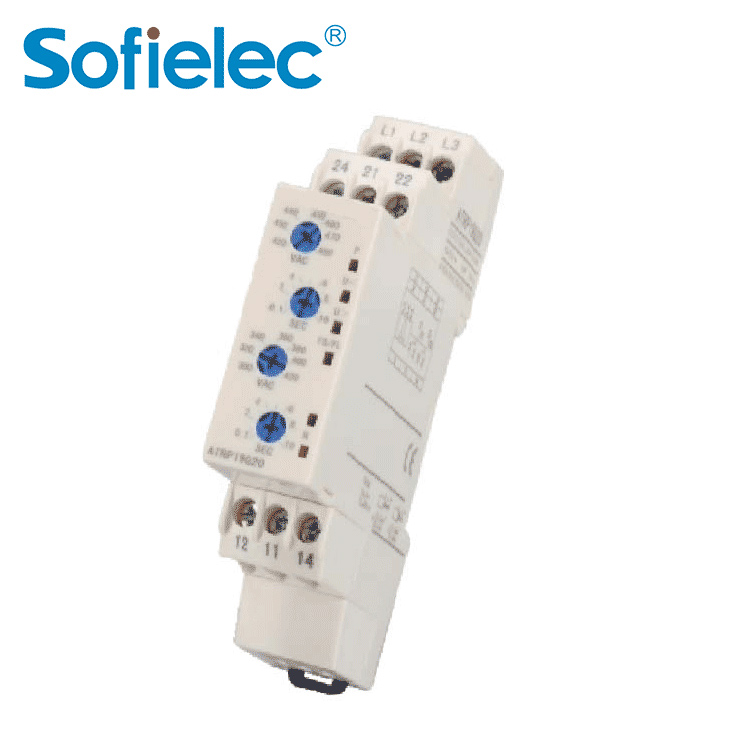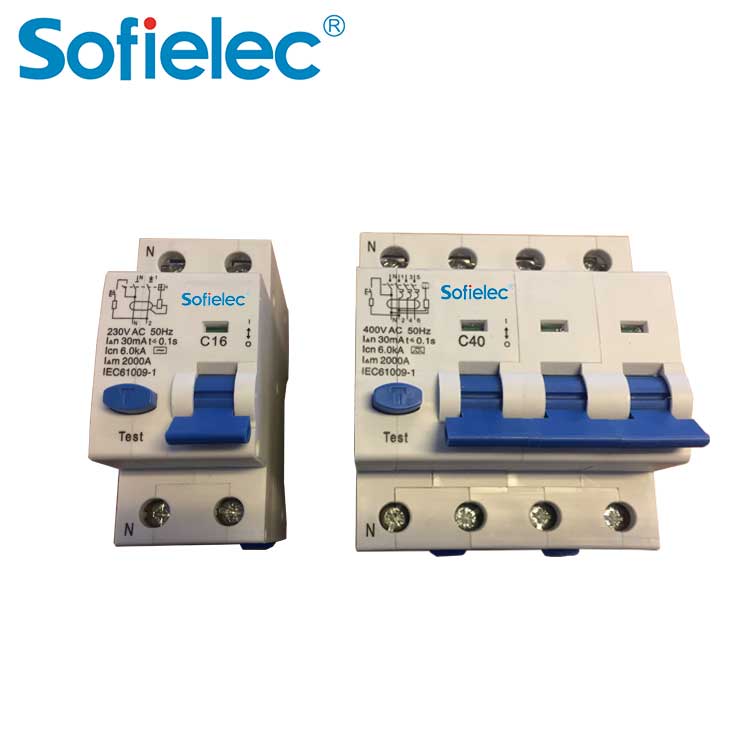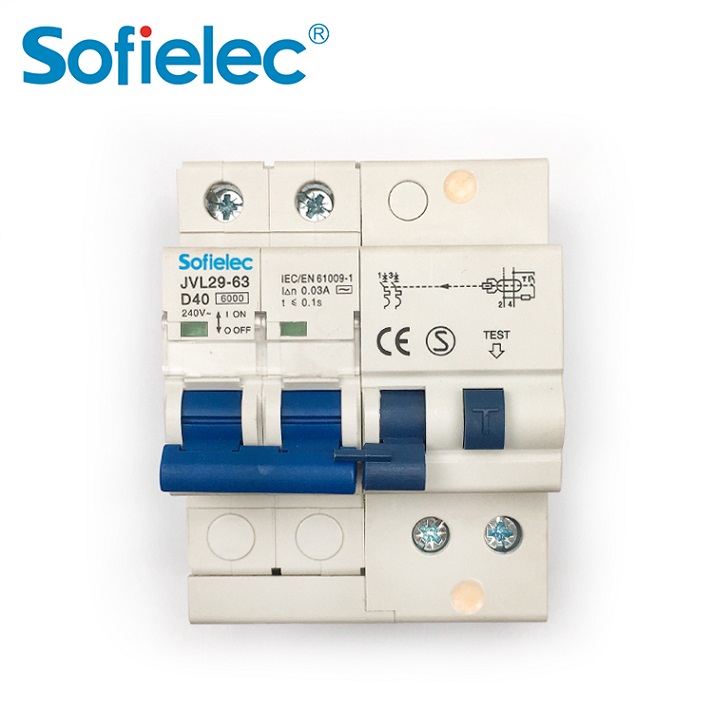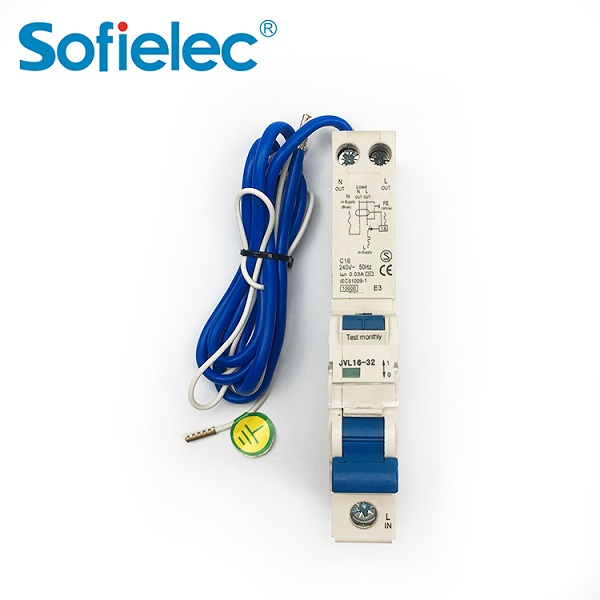| Categories | Time Relay |
| Model | ATRP19G |
| Maximum Switching Voltage | 250 V DC/250V AC |
| [us] Rated Supply Voltage | 300.... 480 V AC 3 phases |
| Supply Voltage Limits | 270...528V AC |
| Power Consumption In Va | <=22VA 400V AC 50Hz |
| Control Circuit Frequency | 50...60 Hz +/- 10% |
| Output Contacts | 1 C/O,2C/O |
| Nominal Output Current | 8A 250VAC |
| Delay At Power Up | <= 650 ms |
| Voltage Range | 270...528 V AC |
| Response Time | 1000ms |
Main
| Product Or Component Type | 3 Phase Voltage Control Relay | |
| Relay Type | Control relay | |
| Product Specific Appli-cation | For 3-phase supply | |
| Relay Name | ATRP 19G00 | ATRP19G20 |
| Relay Monitored Parameters | Phase failure detection, Phase sequence,Phase Asymmetry, Over Voltage and undervoltage | |
| Switching Capacity In Va | 1250 VA | |
Complementary
| Model | ATRP19G00 | ATRP19G20 |
| Maximum Switching Volage | 250 V DC/250V AC | |
| Rated Supply Voltage | 300...480 V AC 3 phases | |
| Supply Voltage Limits | 270... 528 VAC | |
| Adjustable Undervoltage Umin | 300, 320, 340, 360, 380, 400, 420V AC 3 phases | |
| Adjustable Overvoltage Umax | 420 , 430, 440, 450, 460 ,470, 480V AC 3 phases | |
| Power Consumption In Va | <=22VA 400VAC 50Hz | |
| Trip delay time | 0.1S......10S adjustable | |
| Control Circuit Frequency | 50...60Hz +/- 10 % | |
| Output Contacts | 1 C/O | 2C/0 |
| Nominal Output Current | 8A 250VAC | |
| Delay At Power Up | <= 650 ms | |
| Voltage Range | 270...528 VAC | |
| Reset time | 1000ms | |
| Overvoltage Category | III conforming to IEC 60664-1 | |
| Insulation Resistance |
> 500 MOhm at 500 V DC conforming to IEC 60664-1 > 500 MOhm at 500 V DC conforming to IEC 60255-5 |
|
| Supply Frequency | 50/60 Hz +/- 10 % | |
| Operating Position | Any position without | |
| Connections - Terminals |
Screw terminals 2 x 0.2...2x 1.5 mm2 - AWG 24...AWG 16, flexible cable with ca-ble end Screw terminals 1 x .2...1 x 2.5 mm2 - AWG 24...AWG 12, flexible cable with ca-ble end Screw terminals 2 x 0...2 x 2.5 mm2 - AWG 20...AWG 14, solid ceable without cable end Screw terminals 1 x 0.5...1 x 4 mm2 - AWG 20...AWG 11, solid cable without ca-ble end |
|
| Tightening Torque | 0.6....1 N.m conforming to IEC 60947-1 | |
| Status Led |
P: green for power, U<: red for undervoltage, U> : red for Overvoltagc, FS/FL: red for Phase Sequence or Phase failure, R: yellow for relay |
|
| Mounting Support | 35 mm symmetrical DIN rail conforming to EN/IEC 60715 | |
| Electrical Duraiity | 100000 cycles | |
| Mechanical Durability | ≤3000000 cycles | |
| Operating Rate | ≤360 operations/hour under full load | |
| Width | 17.5 mm | |
| Product Weight | 0.13 kg | |
Connection Diagarams

Functions Diagrams

Environment
| Electromagnetic Compatibility |
Immunity for industrial environments conforming to EN/IEC 61000-6-2 Emission standard for residential, commercial and light- industrial environments conforming to EN/IEC 61000-6-3 Emission standard for industrial environments conforming to EN/IEC 61000-6-4 |
| Standards | EN/IEC 60255-1 |
| Ambient Air Temperature For Storage | -40...70 °C |
| Ambient Air Temperature For Operation | 20...50 °C |
| Relative Humidity | 95 % at 55 °C conforming to IEC 60068-2-30 |
| Vibration Resistance | 1 gn(f= 57.6...150 Hz) conforming to IEC 60068-2-6/IEC 60255-21-1 |
| Shock Resistance | 0.35 mm (f=5 ...57.6 Hz) conforming to IEC 60068-2-6/IEC 60255-21-1 |
| Ip Degree Of Protection |
Ip30 (casing) conforming to IEC 60529 IP20 (terminals) conforming to IEC 60529 |
| Pollution Degree | 3 conforming to IEC 60664-1 |
| Diclectric Test Voltage | 2kV1minAC50Hz |
| Non-dissipating Shock Wave | 4kV |
Dimension

> What are the four types of timer switches?
A time switch, often simply referred to as a timer, is a device that automatically controls when an electrical circuit is turned on or off. It's like a programmable ...
> Can You Replace a 10 Amp Breaker with a 20 Amp Breaker?
Replacing a 10-amp circuit breaker with a 20-amp one without a thorough professional evaluation is extremely dangerous and poses a significant fire hazard. Let's ana...
> What Makes a Circuit Breaker Essential for Home Electrical Safety?
Home electrical safety ranks high on every homeowner’s priority list, yet many overlook the quiet workhorse that prevents crises before they start. This device acts ...
> What Scenarios Require the Use of a Residual Current Circuit Breaker?
Electrical safety is a top priority in daily life and work, yet many people are unsure when to use a device that guards against electric shock. This article explains...

